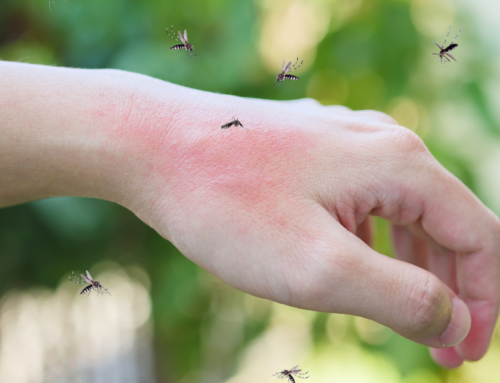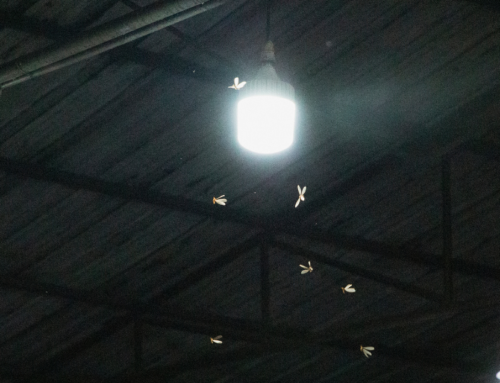Our summertime backyards can be paradises: They have flowering plants and bushes, swimming pools, and even slip ‘n slides. They’re the sites of family dinners and neighborhood barbecues. But our backyards aren’t just human havens — they’re playgrounds for Texas mosquitos. Mosquitos can lay eggs in standing water, from your family’s pool to the dish of a potted plant. And those barbecues? Yeah, they’re smorgasbords for the blood-sucking insects, too. They’re just snacking on you instead of your ‘cue. What do you need to know to survive the summer with these pests threatening your paradise? Here’s a handy guide from your local mosquito exterminator.
How many mosquitos live in Texas?
Texas is home to 85 different varieties of mosquitoes. That’s a Lone Star State–sized portion of the 200 species known to live in the United States. The bloodsuckers arrive around mid-March and can be pesky until October when the weather cools down a bit.
How do mosquitoes affect human health?
According to the City of Austin, “Mosquitoes are among the most important insect pests affecting the health of people.” In other words, they aren’t just annoying pests. They also transmit diseases such as West Nile virus—the most common mosquito-borne virus in the U.S. This disease can strike close to home. In 2020, there were at least 36 pools that tested positive for West Nile Virus and five human cases of the disease in Travis County.
Common types of Texas skeeters are associated with harmful diseases. These include:
Aedes Aegypti (Yellow Fever Mosquito)
This coastal variety is known for breeding inside your home, including in pails, flowerpot plates, and ornamental vases. It’s voracious and is capable of biting anytime. It’s been known to transmit the Zika virus and dengue fever.
Aedes Albopictus (Asian Tiger Mosquito)
Named for its white dorsal stripe and banded legs that give it a tiger-like appearance, this mosquito is strongly attracted to bite humans. But it’s not that particular. It will also feed off Fido and your family cat. It can breed in a container as small as a bottle cap and has been known to carry Zika Virus, West Nile Virus, Dengue Fever, and Yellow Fever.
Culex (House Mosquito)
This is the most common summer pest in Texas. Human body heat draws them in. They’ll breed in any still water, from ponds to water found pooling around your home. They can bring a risk of malaria, yellow fever, encephalitis, dengue fever, and West Nile Virus.
Culex Quinquefasciatus (Southern House Mosquito)
This common brown mosquito prefers to bite birds, but it will commonly enter homes and bite humans in the evening, night, and early morning hours. It’s known as the main carrier of West Nile Virus in the U.S.
How do I know if I have mosquitos?
You might see mosquitos buzzing around outside or hovering above your food, since male mosquitos often feed off plant nectars not blood. But where there’s males, there’s sure to be blood-sucking females as well. You might also find telltale signs mosquitos have been there, such as bite marks on your skin or your pets. These bites can cause mild to severe irritation, swelling, and itching.
Where do mosquitoes live?
Mosquitoes are attracted to any area with standing water, whether a pond or lake, or a backyard pool. They can also lay eggs in soft, moist soil, as well as any shaded area. Female mosquitoes can lay hundreds of eggs at a time.
How long do mosquitoes live?
Mosquitos develop through four stages: egg, larva, pupa, and adult. A female mosquito usually must feed on blood from a human to lay her eggs. Then she’s on the hunt for some stagnant water or damp soil to lay her brood. She lays between a hundred and 400 eggs on a raft that keeps it afloat in the water.
Once a mosquito hatches its eggs in water, they are considered larvae. They look like small worms and will live on the water for four to 14 days as they grow to about ½ an inch long. By this point, it’s considered a pupa. It spends the next one to four days diving and swimming in the water until it can cast off its pupal casing and become an adult. When the mosquito emerges from the water it has wings. It lives for the next three to four weeks as an adult feeding, reproducing, and otherwise causing havoc around your blissful backyard. Because they can live for several weeks, even a single treatment from Austin pest control experts, BrockStar, may not rid you from the pests.
How can I fight mosquitos?
Tiki torches, candles, body sprays. All of these are mosquito repellants, which will deter the pests. However, they won’t rid you of the little suckers. Even DIY sprays won’t banish the buzzers because you may miss spots they like to lay eggs, such as the underside of leaves.
How can Brockstar Pest Services help?
Mosquitos love the humid weather of Texas. As the local Austin, Round Rock, Buda & Kyle, and Dripping Springs pest control services experts since 2012, we know the area—and how to fight these pests until they’re knocked out. Call for a free estimate! 512-800-0437







